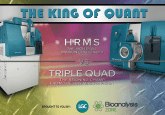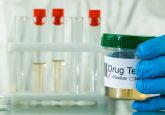Webinar Q&A follow-up: Panel discussion on The rise of Quantitative HRMS

Thank you everyone who attended our live panel discussion on The Rise of Quantitative HRMS. Below are some responses to the questions posed during the live event and from the survey that we did not have time to answer. We hope this is a useful resource and thank our webinar attendees and our speakers, Diego Cortes (PPD® Laboratories), Russell Mortishire-Smith (Waters Corporation), Yves Le Blanc (SCIEX) and Anton Rosenbaum (MedImmune LLC).
Nigel Ewing, Larry Hines and Russell Mortishire-Smith (all from Waters Corporation) respond to some of the questions below.
Q&A follow-up
Describe the current issues, challenges, and/or limitations for large molecule quantification using HRMS
When compared to small molecules, large molecules have a lot of growing up to do. Linear range, absolute sensitivity, dynamic range and other analytical merits are way behind its small molecule counterpart. The size of the molecule and moving it intact from solution phase to gas phase in a robust, consistent, quantifiable manner presents one of the challenges.
Sample affinity, preparation, and isolation are also challenging aspects and need to be more defined and outlined by the FDA and other regulatory agencies.In this environment, intact large molecule quantification is taking a back seat to surrogate peptide quantification.
Many scientists still use tandem quadrupoles. What are the challenges towards adoption of HRMS?
HRMS is perceived as being more of a highly-skilled user technology. In addition, the analytical merits, in particular absolute sensitivity and lower limits of quantitation are still better on the tandem quadrupoles. The throughput on the tandem quadrupoles (TQs) is still faster than the HRMS platforms. TQs are still the gold standard with the regulatory agencies. This is changing and some point in the near future both will be well accepted not only for qualitative analysis but also for quantitative analysis.
Is there a trend toward greater acceptance of HRMS for quantitation by regulatory agencies?
Yes, most recently, Dr. Chris Evans and his team at GSK submitted a peer reviewed publication exploring the development of an HRMS for quantification of a dermal drug.
See the publication in Bioanalysis: “Modify on the fly: triple quad to high resolution in support of a dermal clinical study requiring an ultra low LLOQ,” Bioanalysis, Feb. 2016
Listen to this recent webinar from Dr. Evans on the merits and utility of Tof-HRMS for regulated quantitative bioanalysis: “The ever-expanding role of HRMS in regulated bioanalysis: application to both small molecule and biopharmaceutical study support,” Bioanalysis Zone, Oct. 2015
What, if any, are the software needs for the adoption of HRMS for quantification?
As with any software, it has to have an easy and intuitive graphic user interface (GUI) and enable the user to go effortlessly between quantitative and qualitative analysis. Software must provide sample submission to sample reporting workflows with a transparent dashboard that keeps the user informed on progress of the experiment.
How has the difference in specificity between a tandem quadrupole and an HRMS instrument impacted the quantification market for CROs, pharma, and biopharma?
The selectivity of HRMS has enabled an increase in sensitivity for specific molecules. HRMS is coming to the rescue of analytical assays that are affected by matrix interferences. By excluding the chemical noise an increased level of sensitivity is achieved not attainable on TQs
Furthermore, HRMS affords a new workflow that eliminates the first tuning step searching for an optimal transition. In fact, HRMS pre-cursor to pre-cursor quantification conserves the ion distribution and provides an effective acquisition mode that enables a lower limit of quantitation (LLOQ) for small molecules and small peptides.
How will we validate an assay with FS HRMS? By just using guidelines or do we need something more? i.e., Extraction window fixed?
The ICH and EMA guidelines are very clear around repeatability. Triple quads are faced with the same challenges and regulatory requirements. Regardless of the workflow, the process must follow the described SOP specific to that method.
What software packages does your company have for unknown (untargeted) screening and identifying new compounds/ molecules (for instance new designer drugs or plant toxins)?
Waters offers a comprehensive tool box of software platforms for these applications including Progenesis QI, Progenesis QI for proteomics, Masslynx and its host of market specific software offerings and UNIFI.
Many assays are being developed down to low pg/mL levels using small plasma volumes. Will HRMS be able to handle such low LLOQs in the future?
The tandem quads will continue to be the gold standard for quantification. However, HRMS is a comparable, complementary solution. In fact, the added selectivity due to high mass accuracy being able to ignore chemical noise has provided an edge/advantage to scientists and organizations using HRMS.
Dr. Evans and his team at GSK were able to observe this for their dermal drug. (Modify on the fly: triple quad to high resolution in support of a dermal clinical study requiring an ultra low LLOQ,” Bioanalysis, Feb. 2016). FDA has accepted HRMS qualitative and quantitative data.
Is dynamic range in HRMS a Limitation?
It is not a limitation for Tof-HRMS instruments. In fact, it has been a strength of this high resolution platform.
Does HRMS have a future in regulated bioanalysis or better what does regulated bioana really need?
Yes, most recently, Dr. Chris Evans and his team at GSK submitted a peer reviewed publication exploring the development of a HRMS for quantification of a dermal drug. See the publication in Bioanalysis.“Modify on the fly: triple quad to high resolution in support of a dermal clinical study requiring an ultra low LLOQ,” Bioanalysis, Feb. 2016
Listen to this recent webinar from Dr. Evans on the merits and utility of Tof-HRMS for regulated quantitative bioanalysis: “The ever-expanding role of HRMS in regulated bioanalysis: application to both small molecule and biopharmaceutical study support,” Bioanalysis Zone, Oct. 2015
In addition, the following recent publications discuss this observation.
- Korfmacher W. High-resolution mass spectrometry will dramatically change our drug-discovery bioanalysis procedures. Bioanalysis 3(11), 1169–1171 (2011).
- Zhang NR, Yu S, Tiller P, Yeh S, Mahan E, Emary WB.Quantitation of small molecules using high-resolution accurate mass spectrometers – a different approach for analysis of biological samples. Rapid Commun. Mass Spectrom. 23(7), 1085–1094 (2009).
- Bateman KP, Kellmann M, Muenster H, Papp R, Taylor L. Quantitative-qualitative data acquisition using a benchtop orbitrap mass spectrometer. J. Am. Soc. Mass Spectrom. 20(8), 1441–1450 (2009).
- Kaufmann A, Butcher P, Maden K, Walker S, Widmer M. Quantitative and confirmative performance ofliquid chromatography coupled to high-resolution mass spectrometry compared with tandem mass spectrometry. Rapid Commun. Mass Spectrom. 25(7), 979–992 (2011).
- Kellie JF, Kehler JR, Evans C, Szapacs ME. Application of high-resolution MS for development of peptide and largemolecule drug candidates. Bioanalysis (2016)
What would be the critical factors which require consideration when operating the quan/qual approach when the quantitative data is acquired by a CRO, but the qualitative data is handled by the customer?
Sample integrity will be invaluable as the samples are shipped from CRO to customer. A robust process would involve a quantitative check of representative samples after receipt and prior to delivery. Though chromatographic methods will differ between the two experiments, scientists will want access to the quantitative method as they begin to do their non-targeted analysis.
Do you think the adoption of quantitative HRMS will be industry driven or regulatory driven?
This will inevitably be an industry driven adoption. HRMS is expanding out of its well established and accepted qualitative realm into the growing quantitative needs for both discovery and development labs.






